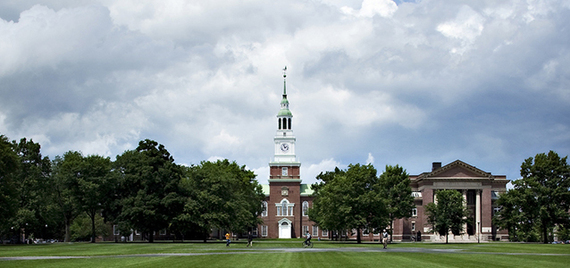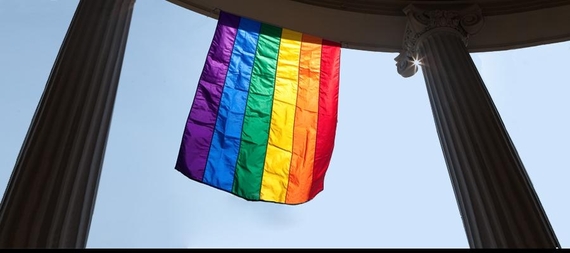As the inaugural speaker for the "Just Words? Free Speech and Social Change" lecture series, hosted by Dartmouth College's Gender Research Institute, critical race theorist and Columbia University Law School professor Kimberlé Crenshaw spoke before an intimate gathering of students, faculty and members of the community. Seated in a small auditorium, the crowd was both racially and ethnically diverse, and also included students and faculty of the queer community.
Crenshaw's lecture comes at a critical juncture for the Ivy League school, which has faced increased scrutiny and commanded the attention of several national media outlets in light of conversations around faculty diversity, inclusivity of marginalized student groups and the role of single-sex Greek organizations in a contemporary university environment.
Dartmouth College President Philip J. Hanlon, an alumnus of the College's Class of 1977, unveiled his vision for the school's future in a highly publicized announcement delivered early the morning of January 29. Dubbed "Moving Dartmouth Forward" (MDF), the plan included more than a year of steering committees, student panels and meetings with the Board of Trustees to gauge how the College would address issues of binge drinking, sexual assault and inclusivity -- what became the three pillars of Hanlon's vision.
With this plan, Hanlon seeks to turn the page in the College's centuries-old history and usher in a new era of inclusivity and academic excellence such that the school may better reflect the ideals and aims that many consider an elite institution should follow.
Shortly after delivering his speech to a crowded auditorium, President Hanlon put forward a longer, written form of his plan. In the plan, written under the headline concerning residential life at the College, Hanlon writes:
We will explore additional avenues to create a more inclusive and diverse environment on and off campus. We will do this because it is right. We also know that a more diverse and inclusive environment will enrich our community and strengthen the academic experience, increasing intellectual growth and innovation.
Given the far-reaching aspects that the plan addressed, it has dominated a large part of campus discourse since its unveiling to mixed reviews from students, faculty and experts. It was within this spirit of remaining critical and open to change that students and faculty audience members took their seats.
Her lecture, entitled "Harriet's Legacy: Navigating Intersectionality in the Age of Post-Racialism," offered a chance to hear an honest and uncensored opinion on race in the United States. With dialogue circulating around race and the ways in which it manifests on our own campus, audience members appeared eager to hear what Crenshaw would say.
Without hesitation, Crenshaw primed her audience with an explanation of post-racialism. Post-racialism, as she described, does not mean the opposite of a racial state -- "nor mission accomplished." More than a noun, she said, post-racialism is a verb. It is something people do, how people act. Post-racialism is a packaging of colorblindness that creates a more conservative, more palatable frame through which we can engage race while avoiding explicit mentions of racism. Crenshaw notes:
"This frame identifies racial issues but does not locate those problems having to do with racial power and structural and institutionalized racism."
Post-racialism, in the words of Crenshaw, has undermined our ability to think critically about the current regime, as this mindset focuses primarily on the uplifting of marginalized voices. Yet it neglects discussion of potential causes of oppression and the pressuring of people of color to lower positions in society. Given the time and setting, Crenshaw's words held even greater meaning for the Dartmouth students and faculty seated before her.
With Crenshaw's words sparking the audience to begin engaging with an abstract consideration of race relations, it wasn't long before a student soon raised his hand asking whether or not Crenshaw believed the Moving Dartmouth Forward plan to be a product of this post-racialism frame.
Having not read the document herself, Crenshaw elected to not offer specific comments on the policy, but shared a more general insight into how similarly-minded policies, like Obama's "My Brother's Keeper" program, address such issues. These policies, she said, tend to focus on identifying potential solutions to work toward rather than emphasizing the various inequities and issues that necessitate them. As President Hanlon states:
Whether it is by increasing diversity in faculty, enrolling a student body that is more representative or providing more social options, we will work to ensure that our community conveys a message of inclusion to every student -- no matter their gender, race, orientation, or socioeconomic background.
In light of Crenshaw's discussion, one could argue that Moving Dartmouth Forward is a strategy with its roots in the post-racialism frame. The plan, however, does not address race alone, and a broader scope of assessing the plan's tenants should include gender and sexual orientation, along with a multitude of identity characteristics -- as nowhere in the plan does Hanlon acknowledge the systemic or institutionalized inequalities and oppression that these minority groups face on campus.
This apparent lack of addressing such inequalities may be most evident in the plan's word choice. Rather than creating an inclusive campus or working toward an equal institution, Moving Dartmouth Forward MDF simply aspires to "convey a message of inclusion..." The focus is not to rectify past circumstances that have caused minority students to feel unsafe or unwelcome at the College, but to address the surface level problems that require relatively easy solutions.
In turning the page on these issues, Hanlon's conceived plan for Dartmouth's future implies that rather than being tired of the problems of diversity itself, we are tired of discussing these criticisms. In not engaging more honestly and openly with issues of racism, sexism or homophobia, what chance is there to move Dartmouth forward in earnest?
Moving Dartmouth Forward, instead of the silver bullet to end inequality on this campus that it was built up as, looks more like a plan to simply move on in hopes of escaping the media's spotlight on said issues.
The larger focus of Crenshaw's presentation centered on intersectionality, a term she is credited for coining that describes how structural systems of marginalization based on gender, race, class or sexual orientation, interact on various levels and result in social inequities.
In an intersectional mindset, it is not adequate to solely address racial or sexual discrimination, but instead how these factors, along with several others, coincide to create unique situations for each student. In neglecting to discuss the experiences of various on-campus minority groups on campus, Dartmouth further risks the continued isolation and marginalization of students with intersectional identities.
To encourage and foster more diverse environments, Moving Dartmouth Forward suggests the College make an effort to admit a greater number of students from diverse backgrounds. This logic that more diversity breeds an openness to diversity may be flawed, but the remedy is still worth pursuing.
As the co-chair of SPECTRA, Dartmouth's foremost LBGT social group, it's clear to me that we would be more self-sustaining if able to reach critical mass. SPECTRA was formed two years ago in the vacuum left by the dissolution of GSX, previously the central LGBT student-group at the time. How Dartmouth's main LGBT group could simply dissolve remains unclear, but the answer may be somewhere in the numbers.
Given the strain of sustaining an organized queer community on campus, it's difficult to imagine groups like Queer People of Color (QPOC), or student groups for lesbians within the Latina population or transgender students in STEM fields thriving at the college. This, however, is not to say the solution is only in the numbers.
What lies at the root of these issues is told by the stories of these students once matriculated. Dartmouth, like many institutions mired in history and tradition, is often slow to accept that these diverse and intersectional students demand more resources than ever before. From mental health outreach to sexual health education, it is not sufficient that these resources be offered, but that they are readily available and tailored to accommodate these individuals.
Seminars and workshops discussing sexual assault, for example, must also speak to the experiences of gay men in terms of how to handle and protect themselves in potentially dangerous same-sex intimate encounters. Sexual assault is not exclusive to Greek houses. It happens when students study abroad, when they accept internships during a summer break and when they return home to visit.
Discussions of sexual assault at Dartmouth's students are geared towards the heteronormative sexual and social relationships that emerge primarily in fraternity basements. Dartmouth cannot afford to fail these students by neglecting to prepare them for the spectrum of situations they may encounter in their futures.
If the development of Moving Dartmouth Forward is any indicator of what is to come, it is clear that it is not just a product, but also a reflection, of the institutionalized inequalities at play on campus and within the administration.
Perspective and current students wish more than the conveyance of inclusion. They require -- and rightfully deserve -- inclusion in the fullest sense of the word. Citing the invisibility and of gay black men and trans women of color, a queer-identifying Dartmouth student asked Crenshaw how she would work against the erasure of intersectional students by institutional forces. Crenshaw responded in saying that you must first "go beyond the myth" by dispelling your assumptions and rejecting the frame, and "ask the other question." More, you must "talk to the excluded and develop the public will."
If diversity and inclusion are to remain compatible pursuits where one must not come at the cost of the other, then we must follow this process and reject the frame in which Moving Dartmouth Forward was conceived and is currently being implemented. If diversity and inclusion are to remain compatible pursuits where one must not come at the cost of the other, then we must dispel our assumptions and both face the true reality and our role in it. For in Moving Dartmouth Forward, we risk leaving behind the very communities President Hanlon and administrators claim to support. In looking at the short run, however, I think asking the various minority communities and stakeholders what we think and how we feel would be a good place to start.
(Photo Credit: Dartmouth College)


